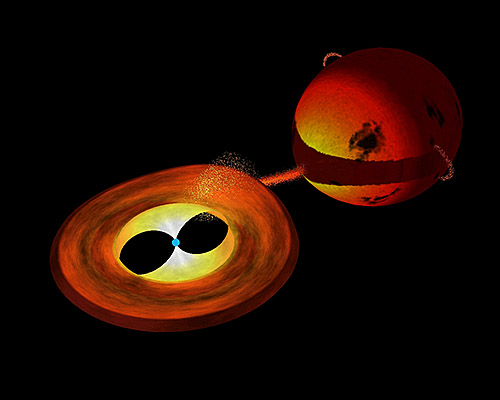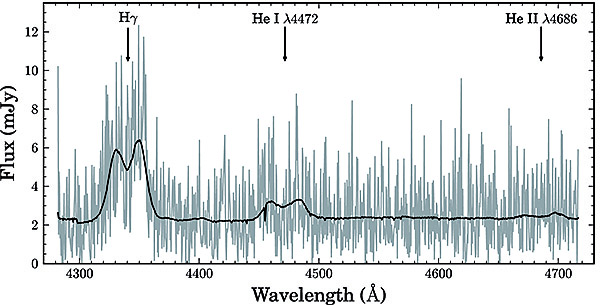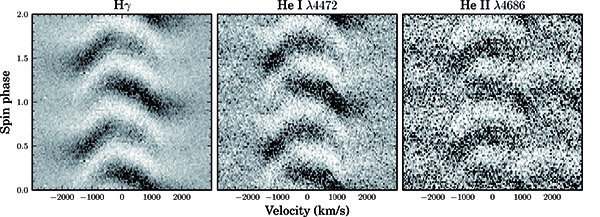Recent William Herschel Telescope observations have revealed a new view of the accretion process in V455 And, an intermediate polar with a very rapidly spinning white dwarf.
This white dwarf, which is a star that is only as large as the Earth but about half as massive as the Sun, spins around its axis in just over one minute, and is the third fastest-spinning
white dwarf known.
Intermediate polars are a type of cataclysmic variable binary star systems. In these stars, a white dwarf accretes matter from a main-sequence companion,
usually via an accretion disc that forms around the white dwarf. In intermediate polars, the white dwarf is moderately magnetic and the magnetic field lines disrupt the inner part of the accretion disc.
Matter gets accreted from the disc to the magnetic poles of the white dwarf via the magnetic field lines. Figure 1 shows an artist's impression of an intermediate polar.
 |
Figure 1. Artist impression of an intermediate polar. Image courtesy of Andrew Beardmore [ JPEG ]. |
Astronomers from the University of Leuven (Belgium), the University of Warwick (UK) and the Universidad de La Laguna (Spain) have used the ISIS
instrument at the WHT to monitor the accretion process in V455 And, an intermediate polar with a white dwarf that spins around its axis in just 67s.
The team wanted to obtain optical spectra with integration times of only a few seconds, in order to clearly resolve the variations in the spectra
during the spin period of the white dwarf.
Taking spectra with such short exposure times of a ~15th magnitude star is technically challenging but was possible by equipping ISIS with the
QUCAM2 CCD instead of its standard chip. QUCAM2 is a Low Light Level CCD (L3CCD) that uses a special serial register
which multiplies the number of electrons in the pixels before the readout takes place. Even a single photon then results in a
signal that dwarfs readout noise in the final image. The CCD also has a frame transfer buffer, that allows one to store an image
while it is being read out so that the CCD is immediately ready to take the next image, eliminating dead time between exposures.
 |
Figure 2. The average (black) spectrum of V455 And overplotted on a single spectrum (grey)
[ JPEG ]. |
While a single spectrum with an integration time of 2 seconds does not reveal much signal, adding several spectra together easily allows detection of several spectral lines.
This is shown in Figure 2, where a single spectrum is shown in grey and the average spectrum of the more than
15000 spectra the team obtained in black. By adding spectra together that were taken 67s apart,
at identical spin phases of the white dwarf, the variations in the emission lines over the 67s cycle could be uncovered.
The variations of the spectra compared to the average spectrum during two spin cycles are shown in Figure 3. While the variations
can probably be explained by the emission from the magnetically controlled accretion near the surface of the white dwarf, e.g.
emission from the accretion curtains, there is currently no specific model available that can reproduce the details uncovered in these observations.
The data therefore present very valuable input for future modelling efforts of the accretion flows in intermediate polars with a
short white dwarf spin period. This study also demonstrates the potential of L3CCDs, such as the QUCAM2 and QUCAM3 CCDs available for
the WHT observers, for the study of rapid variability in relatively faint systems.
 |
Figure 3. Normalised and mean subtracted line profiles, folded on the white dwarf spin period. White indicates lower than average fluxes, black higher than average
[ JPEG ]. |
More information:
S. Bloemen, D. Steeghs, K. De Smedt, J. Vos, B. T. Gaensicke,
T. R. Marsh and P. Rodriguez-Gil, 2013, "Remarkable spectral variability on the spin period of the accreting white dwarf in V455 And",
MNRAS, 429, 3433.
Fast and faint-object spectroscopy with the ISIS QUCAMs.



